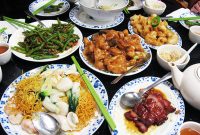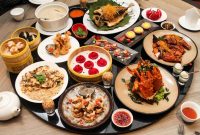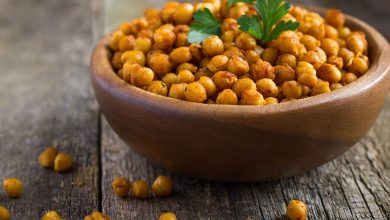Chinese cuisine: traditions and culinary art of Chinese chefs
Chinese cuisine attracts many, but few risk trying to replicate it in their kitchen. It is enough to learn the basics of Chinese cuisine, and you will have the opportunity to discover new facets of the art of cooking.
Chinese cuisine: origins and basics
It seems to almost everyone to be something incredibly difficult. For comparison, Russian cuisine and Chinese cuisine require approximately the same level of preparation and time requirements. The most popular Chinese dish has long been widespread in Russia – this is …
In China, everything is taken seriously. Sports should be with the entire depth of the Shaolin Monastery, the design of the apartment must follow the rules of Feng Shuai, and even in cooking, Confucius was not without.
In the VI-V centuries BC. he not only formulated the basic rules of food etiquette, but also summarized the vast philosophical concepts that existed in Chinese culture. It is significant that the greeting with which the Chinese address each other can be translated as “Have you already eaten?”
In ancient China, the profession of a cook was inseparable from the profession of a doctor.
Chinese cuisine is based on the oldest culinary traditions and is one of the richest and most popular in the world. The first cookbooks appeared in China fifteen hundred years ago, and the basic canons of cooking have remained unchanged for several centuries.
The vast territory of the country, the difference in its climatic conditions, the diversity of flora and fauna predetermined a rich menu and variety in the combination and methods of culinary processing of the initial products. Traditionally, Chinese cuisine is categorized by region, with Beijing (northern), Shandong (eastern), Sichuan (western), and Cantonese (southern) culinary schools. Peking, “imperial” cuisine …

Chinese cuisine began to spread to other continents only from the beginning of the 20th century.
It is noteworthy that Chinese catering restaurants, in whatever country they are located, have never had a direct impact on the local cuisine. This can be explained primarily by the specific features of Chinese cuisine, which is very different not only from European, but also from, for example, cuisines such as Caucasian, Indian, and Middle Eastern countries.
To understand the fundamental difference between Chinese and European cuisine, it is enough to recall the following historical facts.
For example, French culinary art began to evolve into classical French cuisine in the 17th century and reached its completion at the end of the 18th century.
ROLE OF SPICES AND CONDITIONS IN CHINESE CUISINE
The role of spices and seasonings in Chinese cuisine is enormous, since it is these products that largely shape the taste and aroma of any dish. With the help of such additives, the Chinese get rid of the undesirable smell of game, fish, and reduce the fatty component of the finished dish.
In addition, all kinds of sauces and spices are used, which have specific properties that allow them to perform a number of functions in the cooking process. It should also be borne in mind that many condiments are rich in nutrients with some degree of health benefits.
The Chinese have such a concept as “five taste sensations”, namely: sweet, salty, sour, bitter, spicy. Salty prevails over all, improving the taste …
Chinese cuisine is multifaceted and immense.
It seems to the inhabitants of Europe that they know everything about the national cuisine of China, and there is nothing more to surprise them, but this does not reflect reality at all. The mass consumer from European countries is familiar with only a small fraction of the dishes that are offered by restaurants scattered across the cities and towns of vast China.
Like Russia, there are many regions in China that are radically different in climate, agricultural and livestock opportunities – these features have left their mark for centuries, and nowadays, approaches to traditional Chinese cuisine differ from province to province.

They are trying to classify and divide Chinese cuisine into certain schools, uniting them into groups that have similar features …
“Why are the Chinese eating and not getting fat?”
Two frequently asked questions in Russian-Chinese intercultural communication: 1. How can they eat so much and remain so thin? (Russians about the Chinese) 2. Why are Russian women so slender and beautiful before giving birth, and after they get fat and don’t lose weight? (Chinese about Russians)
“Traditional Chinese food: what and how do they eat in China?”
The origins of Chinese cuisine began over 3 thousand years ago. During the excavation of ancient cities in 221 BC and the sites of ancient people, archaeologists constantly discover kitchen boards, plates made of bronze, pots and knives.
The first Chinese cookery book was written 1,500 years ago. Since ancient times, in the Middle Kingdom, cooking was at the level of art, to which there was a very serious approach.
The first and invariable requirement of the Chinese for food is a pleasant taste, benefits and medicinal properties. The kitchen also divided foods into yin and yang, which should always be balanced.
The Chinese treat food with respect, love to arrange joint family dinners and feasts with …
Chinese cuisine takes it to the next level
In large Chinese cities, the national cuisine does not give up under the onslaught of Japanese sushi, but undergoes some changes. In particular, they move to the molecular level.
Owned by Mr. Leung, Bo Innovation Restaurant maintains its reputation with X-Terme Chinese gourmet cuisine. “Leung is the kind of guy who can make the classic Chinese Xiao lug dumplings, filled with broth and a drop of egg,” say the Chinese restaurateur’s colleagues. Recall that …



